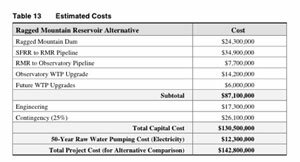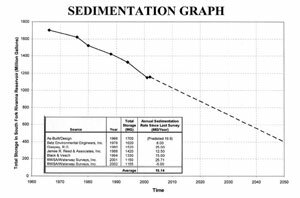Higher and higher: Frederick claimed dredge cost $225 million

There's nothing in the budget of the 50-year water plan for dredging the Rivanna Reservoir...

...even though it will be less than a third its current size by 2050
RIVANNA WATER & SEWER AUTHORITY
Some local officials seem determined to emphasize the obstacles to dredging the area's main reservoir even though others suggest the process may require less regulation– and less money– than some supposed experts have claimed.
"It's 14 different regulatory agencies to do any of that stuff," said City manager Gary O'Connell at the March 3 City Council meeting, rejecting suggestions that dredging might be a viable option for saving the Rivanna Reservoir and dismissing any notion of dirt-sharing between that silt-choked water body and the nearby Charlottesville-Albemarle Airport.
And yet a key meeting between local officials and regulators [PDF] nearly three years ago indicates that dredging can win regulatory approval. For instance, an official with the Army Corps of Engineers told the assembled leaders, including O'Connell, at the April 18, 2005, meeting that as long as the dirt was not dumped in a wetland or waterway, the Corps wouldn't have any regulatory role.
The state Department of Environmental Quality went further: the department's environmental manager, Joseph Hassell, told O'Connell and others that the agency "had never expressed any opposition to dredging based on its environmental impacts," according to the minutes of the meeting. "The impacts to water quality would be temporary," Hassell reportedly said. "The impacts to wetlands, as long as the disposal was upland, would be zero."
There must be some reason why top local officials refuse to save the Rivanna Reservoir from the annual onslaught of silt, but so far a new group of retired leaders questioning the official $143 million water plan hasn't found it.
The new group, Citizens for a Sustainable Water Plan, claims that local planners have dug in their heels after relying on a single, hand-picked consultant to steer the community away from dredging its main reservoir.
Waterworks chief Tom Frederick is sticking to his guns– and hauling out additional firepower. Dredging, he says, will not cost $127 to $145 million– 2004 estimates already blasted as wildly overstated– but could actually reach $225 million.
"This is nothing but desperate hand waving," says former City Councilor Kevin Lynch, part of the new citzens group. "It's an attempt to scare the public from doing the right thing environmentally and the smart thing fiscally."
It was questions from Lynch and Kendra Hamilton at the November 19 City Council meeting [PDF] that brought the new estimate to the public's attention. Hamilton asked Frederick, director of the Rivanna Water and Sewer Authority, for documentation that dredging was too expensive, and he responded that he had gone back to his consultants for a dredging update, and they had found that returning the Rivanna Reservoir to its original capacity would now cost $200-225 million.
"We'll soon be posting their report to our website," Frederick told Council that night.
That was three and a half months ago. Both Lynch and Hamilton have finished their terms in office, and yet the report hasn't made its way to rivanna.org. Nor was Frederick able to produce the written estimate at a pre-arranged meeting with a Hook reporter and an editor on Tuesday, March 4.
"I couldn't find it, and they're supposed to be getting me something," Frederick said Tuesday.
At issue is the Rivanna Reservoir, which Authority documents show to be shrinking to less than one third its original size. While some want to save the Reservoir, Frederick and several leaders of green organizations have backed a 50-year plan to shift the main water supply to a new Ragged Mountain Reservoir created by a 112-foot tall dam and a 9.5-mile pipeline [PDF].
Frederick wants the Hook to run a correction to last week's cover story ["Reservoir dogged: A $142 million boondoggle?"} because it allegedly erred by suggesting that dredging would save the community tens of millions of dollars. In the March 4 meeting, also attended by City and County chief spokespersons Ric Barrick and Lee Catlin, Frederick claimed the Hook used "apples-to-oranges" comparisons when it mentioned dredging as way to provide water storage.
Frederick has been a vocal supporter of a 50-year, $143-million water plan that also includes new and replacement pipelines, as well as treatment plant upgrades, things he contends the community must fund whether or not the Authority moves forward with its controversial plan to focus most of its water storage in a single Ragged Mountain Reservoir.
The new reservoir would depend on water brought in from the Rivanna River via a $60 million pipeline, while the area's two primary reservoirs, Sugar Hollow and Rivanna, would continue to fill with silt.
The Hook found last week that hydraulic dredging– a sort of underwater vacuuming operation– is widely seen as the simplest and most environmentally friendly of water-supply efforts. It simply restores the volume of existing reservoirs instead of– as the present plan proposes– clear-cutting over 100 acres of mature forest, building a new dam, and creating a lake stretching all the way to– and even under– Interstate 64. Yet dredging fell off the list of local alternatives after the lone estimate from the hand-picked consultant.
What is at issue is how that happened. By June 2006, both Albemarle Supervisors and Charlottesville City Councilors unanimously endorsed Frederick's 50-year water plan prior to holding their own public hearings. Frederick points out that the Authority held a dozen hearings.
Did the Rivanna Authority rely too heavily on a single consulting firm that critics charge has overestimated the cost of dredging? While Pennsylvania-based Gannett Fleming claimed in 2004 that dredging five million yards of accumulated silt out of the Rivanna reservoir would cost between $127 million and $145 million, the Hook reported last week that two private contractors provided figures suggesting the job could be done for $38.5 to $57.5 million.
Since that article and other media coverage, organizers of the new citizens group say that dredging deserves a second look– especially since the Airport is contemplating the purchase of two million cubic feet of dirt for a runway extension.
What's hard to find is a clear example of a Virginia reservoir that's been dredged. The only one the Hook could find was a 1997 project for the City of Fairfax. There, 200,000 cubic yards of material were removed from the reservoir for a total cost, including disposal, of $2.44 million. Although Fairfax utilities director John Boryschuk warns against making comparisons due to myriad project variables, for a project the size of the Rivanna Reservoir, that would extrapolate, ignoring inflation, to $61 million.
Indeed, as the Hook reported in last week's cover story, at least one dredging company– stunned by what our leaders claim dredging costs– is now already angling for the business.
Meanwhile, the two reservoirs, according to the Authority's hand-picked consultants, are filling with sediment. While Frederick vehemently denies that the two reservoirs have been left to fill with silt, he concedes that nowhere in his $142 million, 50-year water plan is any money budgeted for dredging.
At the March 3 meeting of City Council, Charlottesville Mayor Dave Norris agreed to hold a work session on the water plan. At presstime, according to Council Clerk Jeanne Cox, a date for that meeting had not been set.
#